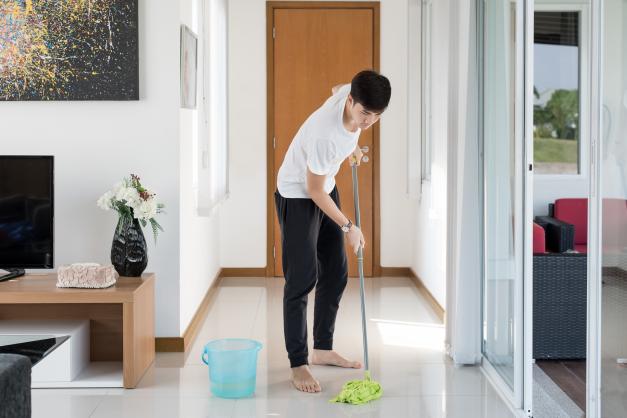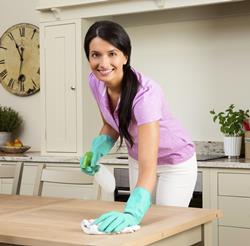
Whether for move out cleaning or just keeping your place, here are the tasks that should be on your list.
Just because you don’t "own" your place doesn’t mean you shouldn’t have a regular cleaning routine to keep your environment fresh and in good condition. Cleaning on a regular basis makes the job easier when you do tackle these tasks – and what’s more, keeping your rental in good shape helps ensure that you’ll get your deposit back when your lease is up! Follow these tips … but always read the product label for exact household cleaning product usage instructions.
In the Kitchen
Appliances
Outside surfaces: Avoid abrasive cleansers. Wipe up spills immediately with a dry cloth to prevent discoloration, and allow cooking surfaces to cool before cleaning.
Inside the refrigerator: Use a solution of baking soda and water to avoid scratching the surface.
Inside the oven (if not self-cleaning): Use oven cleaner. (Don't use oven cleaner on a self-cleaning or continuous cleaning oven because it may damage the surface.)
Porcelain sinks: nonabrasive, all-purpose cleaner disinfectant cleaner mild abrasive (liquid or powder cleanser)
Glass cooktops: Use cleaner formulated for ceramic glass or a paste of baking soda and water and apply to a cooled cooktop with a clean nonabrasive sponge or paper towel; rinse and dry thoroughly.
Countertops
Laminated surfaces: Prevent damage by using a trivet or insulated pad to protect surfaces from hot pans, and always use a cutting board. Clean with nonabrasive, all-purpose cleaner (without bleach) and wipe up cleaning solutions immediately to prevent discoloration. Never use scrapers or abrasive pads; instead, try a soft vegetable brush to clean textured countertops.
Solid surfaces: Use a nonabrasive or abrasive all-purpose cleaner on matte (no-shine) surfaces, and nonabrasive all-purpose cleaners on satin or high-gloss finishes. Avoid damaging the surface by using trivets and cutting boards.
Wood block: Wipe up spills and liquids immediately to prevent warping, and clean with a wood cleaner.
Cabinets
Use a product that cleans finished wood to remove fingerprints, smudges and other soils. A polish or wax may be used if a shine is desired. Buff with a soft cloth. Be sure wood is properly finished. Any substance, even water, used on unfinished or improperly finished wood can damage the surface.
In the Bathroom
Toilet
 For the inside: Use toilet bowl cleaner and a long-handled toilet brush to clean rim holes and the trap. Attach an in-tank (continuous) cleaner to maintain the freshness of the bowl (but remove it before using toilet bowl cleaner - don’t mix the products).
For the inside: Use toilet bowl cleaner and a long-handled toilet brush to clean rim holes and the trap. Attach an in-tank (continuous) cleaner to maintain the freshness of the bowl (but remove it before using toilet bowl cleaner - don’t mix the products).
For the outside: Use a nonabrasive, all-purpose cleaner or disinfectant cleaner on the exterior of the toilet and the toilet seat. Thoroughly rinse and dry hinge areas and bumpers.
Tub/Shower/Sink
Mold and Mildew Prevention: Use the fan (or open a window) when showering. Wipe down the tub walls with a sponge after bathing; use a towel or a squeegee on shower walls. Keep shower doors and curtains open after use to allow them to air dry.
Tub, Sink, and Tile: Rinse the tub and sink after each use to prevent buildup. Clean regularly with a nonabrasive, all-purpose cleaner; tub/tile/sink cleaner; or liquid cleanser and rinse with clean water. Avoid using powdered abrasive cleansers that could scratch surfaces. Dry and buff tile, faucets and handles to prevent water spots. Try a daily shower cleaner to keep shower and tub surfaces free of buildup: just spritz it on and go – no scrubbing or rinsing required!
Grout: Clean with a solution 3/4 cup of liquid household bleach to 1 gallon of water or a mildew stain remover, applied carefully with a soft-bristled brush. Rinse thoroughly.
Stain-Solvers:
- Mildew: Use liquid household bleach or cleaners with bleach to remove stains.
- Rust: Only use a rust remover for such stains (not a cleaner with bleach).
- Stubborn stains or soap film buildup: Use disinfectant cleaner; allow it to penetrate thoroughly, then rub or scour.
In Living Areas
Painted Walls: Using a nonabrasive, all-purpose cleaner or a wood cleaner, test the "washability" of the surface first by washing an inconspicuous area. To clean, start at the bottom of the wall and work up to the ceiling, overlapping areas as you clean and using a circular motion.
Woodwork: Remove dust with a dusting product; spray it onto the surface or onto a dusting cloth. Remove stains and add shine with furniture cleaner, cleaner-polish or polish applied with a clean soft cloth.
Flooring: Mix a nonabrasive, all-purpose cleaner with warm water; use a mop, sponge or cloth dipped in the solution and wrung out. Some products require rinsing, others do not -- so check the label. A floor cleaner with polish can help fill in scratches and add shine.
Carpet: Vacuum regularly to remove dirt and allergens, and treat spills immediately with a carpet-cleaning product.